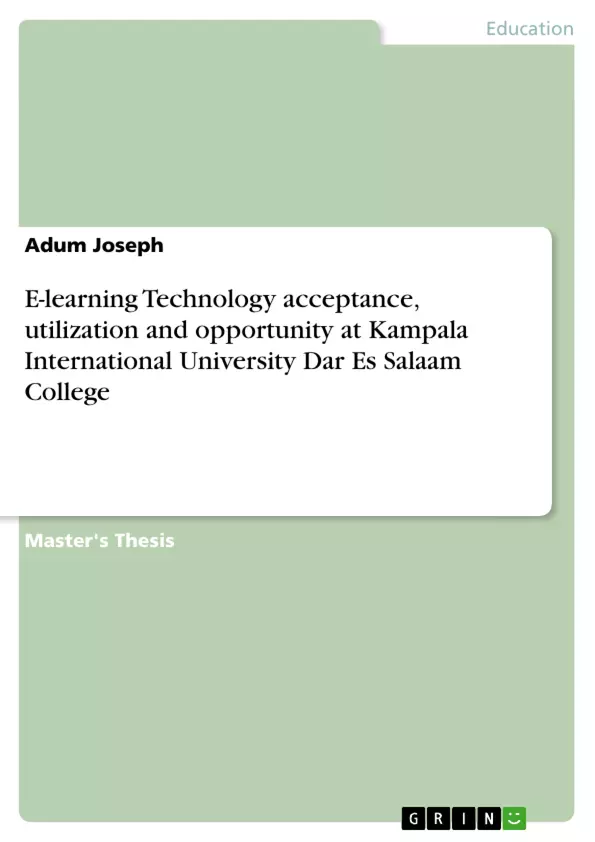ABSTRACT
The purpose of this research was to find out the acceptance and usage of e-learning technologies, the opportunities brought about by e-learning technologies, and challenges faced in e-learning at Kampala International University. The descriptive survey research design was used, and the respondents were students with a total population of 1780 who were randomly selected. The main instrument was a questionnaire that was distributed to the respondents. The researcher collected 267 completed questionnaires out of a total of 326. Data were analyzed using mean, standard deviation, frequency and statistics. The findings showed that Technology and System is the major factor influencing the acceptance of e-learning technology in Kampala International University. Average usage of e-learning technology was demonstrated at Kampala International University, and several important opportunities in education were determined. The students faced lack of technical support and access to computers as the main challenges when they needed to access course materials online and interaction with other online students. They also encountered several technological challenges such as access to computer equipments from the labs, technical skills to access computer technology and the e-learning system especially learning management system, and the quality of e-learning computer facilities and technology. It is therefore recommended that the management should be interested in supporting the development of e-learning technology and be willing to recognize the challenges students face and to provide the necessary policy and practical support to help overcome these challenges if they wish to promote the use of e-learning technologies as a part of the delivery of course materials in Kampala International University.
Inhaltsverzeichnis (Table of Contents)
- Chapter One: Introduction
- 1.1 Background of the Study
- 1.2 Statement of the Problem
- 1.3 Objectives of the Study
- 1.4 Research Questions
- 1.5 Significance of the Study
- 1.6 Scope and Delimitation of the Study
- 1.7 Definition of Key Terms
- Chapter Two: Literature Review
- 2.1 Theories and Models of Technology Acceptance
- 2.2 E-learning Adoption and Utilization
- 2.3 Benefits of E-learning
- 2.4 Challenges of E-learning
- Chapter Three: Research Methodology
- 3.1 Research Design
- 3.2 Target Population and Sampling Technique
- 3.3 Data Collection Instruments
- 3.4 Data Analysis Techniques
- Chapter Four: Data Presentation and Analysis
- 4.1 Demographic Characteristics
- 4.2 Analysis of Technology Acceptance
- 4.3 Analysis of E-learning Utilization
- 4.4 Opportunities and Challenges of E-learning
- Chapter Five: Discussion, Conclusion and Recommendations
Zielsetzung und Themenschwerpunkte (Objectives and Key Themes)
This research aims to examine the acceptance, utilization, and opportunities of e-learning technology at Kampala International University Dar es Salaam College. It investigates the factors influencing student adoption and use of e-learning resources and explores the potential benefits and challenges associated with this approach to education.
- Technology Acceptance Models: The study explores and applies relevant theories and models of technology acceptance, such as the Technology Acceptance Model (TAM) and the Unified Theory of Acceptance and Use of Technology (UTAUT), to understand the factors driving student adoption of e-learning technologies.
- E-learning Implementation and Utilization: The research investigates the extent to which e-learning technologies are implemented and utilized at Kampala International University Dar es Salaam College, focusing on student perceptions and experiences.
- Opportunities and Challenges: The study analyzes the opportunities presented by e-learning, such as enhanced learning experiences, flexibility, and cost-effectiveness, as well as challenges such as accessibility, technical infrastructure, and student preparedness.
- Impact on Student Learning: The research explores the impact of e-learning on student learning outcomes and assesses the effectiveness of e-learning as an educational approach.
Zusammenfassung der Kapitel (Chapter Summaries)
Chapter One provides an introduction to the study, outlining the background, problem statement, objectives, research questions, significance, scope, and definition of key terms. This chapter sets the context for the investigation into e-learning acceptance and utilization at Kampala International University Dar es Salaam College.
Chapter Two presents a comprehensive literature review, exploring relevant theories and models of technology acceptance, examining e-learning adoption and utilization in educational settings, and discussing the benefits and challenges associated with e-learning.
Chapter Three details the research methodology employed in the study, covering the research design, target population and sampling technique, data collection instruments, and data analysis techniques used to gather and analyze information related to e-learning at the university.
Chapter Four presents and analyzes the collected data, providing insights into the demographic characteristics of the study participants, their technology acceptance levels, e-learning utilization patterns, and perceptions of opportunities and challenges related to e-learning.
Schlüsselwörter (Keywords)
E-learning, Technology Acceptance, Utilization, Opportunities, Kampala International University, Dar es Salaam College, Higher Education, Student Perceptions, Technology Acceptance Model (TAM), Unified Theory of Acceptance and Use of Technology (UTAUT), Educational Technology.
- Citar trabajo
- Adum Joseph (Autor), 2012, E-learning Technology acceptance, utilization and opportunity at Kampala International University Dar Es Salaam College, Múnich, GRIN Verlag, https://www.grin.com/document/206345



